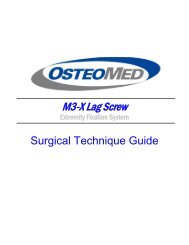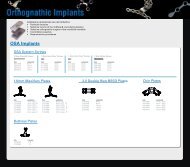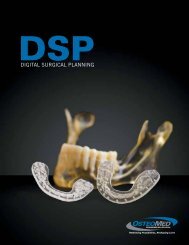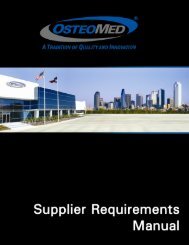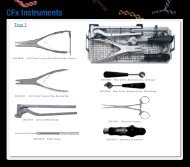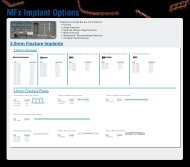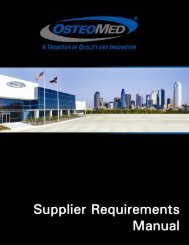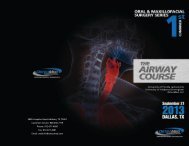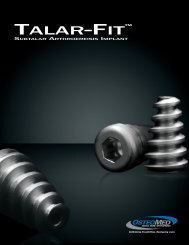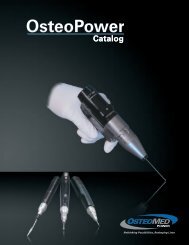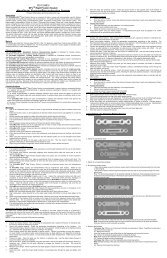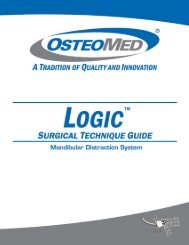increased fracture toughness improves clinical utility of ... - OsteoMed
increased fracture toughness improves clinical utility of ... - OsteoMed
increased fracture toughness improves clinical utility of ... - OsteoMed
You also want an ePaper? Increase the reach of your titles
YUMPU automatically turns print PDFs into web optimized ePapers that Google loves.
INCREASED FRACTURE TOUGHNESS IMPROVES CLINICAL UTILITY OF A NOVEL CALCIUM<br />
PHOSPHATE CEMENT<br />
Lin J*, Lee WJ* + , Yetkinler DN*, Constantz BR* +<br />
*Skeletal Kinetics, Cupertino, CA 95014, + Stanford University, Stanford, CA 94305<br />
janice@skeletalkinetics.com<br />
Introduction<br />
The use <strong>of</strong> calcium phosphate cements with surgical hardware has been prohibitive due to their brittleness and inability to halt crack propagation during and<br />
after setting. As a result, despite the biocompatible and osteoconductive advantages <strong>of</strong> mineral-based cements over polymeric cements, surgeons are<br />
instructed to implant calcium phosphate cements after definitive hardware placement, which is a backwards notion to most.<br />
Fracture <strong>toughness</strong>, a mechanical property measuring a material’s resistance to fracturing catastrophically from a pre-existing crack, is an important<br />
factor when determining the suitability <strong>of</strong> a cement to be used in conjunction with hardware. Once a cement is set, <strong>fracture</strong> <strong>toughness</strong> indicates a cement’s<br />
ability to resist propagation <strong>of</strong> cracks created by hardware placement, as well as its integrity during physiologic loading.<br />
In the interest <strong>of</strong> engineering more accommodating calcium phosphate cements that will tolerate early hardware placement, this study measured the<br />
<strong>fracture</strong> <strong>toughness</strong> <strong>of</strong> two novel calcium phosphate cements, OsteoVation Inject and OsteoVation Impact (Skeletal Kinetics, Cupertino CA). BoneSource®<br />
(Stryker Howmedica Osteonics, Mahwah NJ), a first generation calcium phosphate cement, was measured quantitatively and qualitatively for comparison.<br />
Methods<br />
Single edge notched tension specimens <strong>of</strong> OsteoVation and BoneSource measuring 50 x 16 x 8 mm (L x W x T) with a 6 mm radius notch were prepared by<br />
mixing each device, filling an acetal mold, and clamping a cover onto the mold with minimal pressurization <strong>of</strong> the material. Each specimen was allowed to<br />
cure in 37C, pH=7.4, phosphate buffered saline for various lengths <strong>of</strong> time: 20 min., 24 and 48 hr. Fracture <strong>toughness</strong> at ~20 min. may be interpreted as the<br />
cement’s tolerance to drilling and screw insertion that occurs during an operation. By 48 hrs., the cement is expected to attain ultimate <strong>fracture</strong> <strong>toughness</strong>,<br />
corresponding to its conversion to apatite.<br />
After the specified curing time, two holes aligned longitudinally along the specimen were drilled into each specimen for mounting rod placement. A<br />
1.2 mm pre-crack was sawed into the notch, and the specimen was mounted on a mechanical testing machine (Instron, Canton MA). Care was taken to<br />
ensure specimens were properly aligned on the mechanical testing machine to prevent non-axial loads. Specimens were tested in a wet environment while<br />
tensile forces were applied to the specimen at a displacement control rate <strong>of</strong> 42.3 m/s.<br />
Fracture <strong>toughness</strong> was calculated by the following stress intensity formula [1]. Statistical analysis was performed with a two-tailed Student’s t-test<br />
(α = 0.05).<br />
K C = a {1.99 – 0.41(a/W) + 18.7(a/W) 2 – 38.48(a/W) 3 + 53.85(a/W) 4 }<br />
where K C = stress intensity factory (MPam) = notch tensile strength (MPa) a = notch radius (m) <br />
W = width <strong>of</strong> specimen (m)<br />
A qualitative assessment <strong>of</strong> whether OsteoVation and BoneSource would accept drilling and screw insertion was performed by mixing each device<br />
per manufacturer’s instructions, forming a bolus <strong>of</strong> material ~ 3 cm in diameter, and allowing each cement to set for 20 min. in a <strong>clinical</strong>ly relevant,<br />
physiologic environment: 32°C, pH = 7.4, phosphate buffered saline. Afterwards, a 2.5 mm pilot hole was drilled into the cement bolus and a 3.5 mm selftapping<br />
cancellous bone screw was threaded into the hole.<br />
Results<br />
All specimens <strong>fracture</strong>d at the notch. Fracture <strong>toughness</strong> was obtained by averaging data from four samples; results are summarized in Table 1. The <strong>fracture</strong><br />
<strong>toughness</strong> <strong>of</strong> OsteoVation Inject and OsteoVation Impact were each statistically greater than that <strong>of</strong> BoneSource at each time point (p ≤ 0.05). In addition,<br />
the <strong>fracture</strong> <strong>toughness</strong> <strong>of</strong> OsteoVation Impact was significantly greater than OsteoVation Inject at 20 min. (p = 0.04), but no difference was detected at 24<br />
and 48 hr.<br />
Table 1. Fracture <strong>toughness</strong> increase <strong>of</strong> BoneSource, OsteoVation Inject, and OsteoVation Impact calcium phosphate cements over 48 hrs.<br />
Time, post implantationStress intensity factor, K C (MPa√m)BoneSourceCallos InjectCallos Impact20 minutes0.02 ± 0.010.10 ± 0.010.11 ± 0.0124 hours0.20<br />
± 0.010.47 ± 0.030.58 ± 0.0848 hours0.34 ± 0.050.47 ± 0.080.58 ± 0.04<br />
Qualitatively, OsteoVation Inject and OsteoVation Impact tolerated drilling and screw insertion without fracturing within 20 min. <strong>of</strong> curing in a<br />
physiologic environment. Specifically, OsteoVation Inject and OsteoVation Impact accepted hardware placement after curing 10 min. and 5 min.,<br />
respectively. BoneSource was observed to be too s<strong>of</strong>t after curing 20 min. to drill a clean pilot hole, and subsequently, there was no purchase when the<br />
screw was threaded into the hole.<br />
Discussion<br />
The higher <strong>fracture</strong> <strong>toughness</strong> <strong>of</strong> OsteoVation Inject and OsteoVation Impact indicate a greater tolerance than BoneSource to hardware placement during and<br />
after setting. Furthermore, OsteoVation Impact demonstrated the ability to accept hardware placement even earlier than OsteoVation Inject. However, by<br />
48 hr. both OsteoVation Inject and OsteoVation Impact cured into a material <strong>of</strong> comparable integrity.<br />
Similar findings were reported by Morgan et al. [2] for BoneSource and another first generation calcium phosphate cement: after curing 48 hr.,<br />
BoneSource had a <strong>fracture</strong> <strong>toughness</strong> <strong>of</strong> 0.23 MPa√m and Norian SRS (Synthes Corp, Paoli PA) had a <strong>fracture</strong> <strong>toughness</strong> <strong>of</strong> 0.14 MPa√m.<br />
Conclusion<br />
OsteoVation Inject and OsteoVation Impact possess significantly greater structural integrity than BoneSource and Norian SRS, allowing surgeons to implant<br />
the cement prior to hardware placement, the standard and preferred treatment methodology. In addition, the high <strong>fracture</strong> <strong>toughness</strong> <strong>of</strong> OsteoVation cements<br />
48 hr. post-implantation suggests their ability to limit crack propagation under long term physiologic loading. Thus, surgeons can achieve a strong construct
<strong>of</strong> hardware and cement that resists catastrophic failure with OsteoVation Inject and OsteoVation Impact calcium phosphate cements.<br />
References<br />
1. Gross B, Stawley J, Brown Jr. WF, NASA Tech Note D-2395, NASA. Aug. 1964.<br />
2. Morgan J, Dauskardt RH, Notch strength insensitivity <strong>of</strong> self-setting hydroxyapatite bone cements, J Materials Science: Materials in Medicine, 14 (2004)<br />
647-653.



